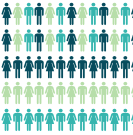Creativity, interdiscipline and design for Innovation
Main Article Content
Abstract
Innovation requires of the interaction of several disciplinary views and of the collaboration of individuals with different abilities. There is no innovation without creativity, which positions it as a fundamental methodological instrument in the professional exercise. To meet this requirement, universities have incorporated several courses and programs oriented to develop entrepreneurial skills, creativity and innovation. However, there is not enough evidence about the effect that these courses have in their students. Different authors have observed creative processes and designer’s abilities, trying to find a replicable methodological device which facilitates innovation processes. This article sets out the preliminary results of the inaugural research project of the research area of design faculty “characterization of the creative process of interdisciplinary equipment” which seeks to characterize the creative process of interdisciplinary teams, identifying the particularities that each discipline contributes to the process. For that purpose, there were organized unidisciplinary and interdisciplinary groups with students of 5th year from the three degrees participating in Icubo: design, engineering, and business. Inside the nterdisciplinary work teams, there were groups of dLab students, trained on creativity and with experience in interdisciplinary work and control groups formed by students of the same majors, who did not participate in the dlab program.
Article Details
References
Baeza, F. (2012) Innovación para una economía competitiva. Fundación Cotec. Economía aragonesa. N° 43. Publicación cuatrimestral de la Caja de Ahorros y M. P. de Zaragoza, Aragón y Rioja.
Ball, L. J., & Christensen, B.T. (2009). Analogical reasoning and mental simulation in design: two strategies linked to uncertainty resolution. Design Studies, 30, 169-186.
Brown, T. (2009). Change by design. How Design Thinking transforms organizations and inspires innovation. New York: HarperCollins Publishers. Carevic, M. (2006) Teoría sobre la creatividad. Marzo 2013 [Disponible en: http://www.psicologia-online.com/articulos/2006/creatividad.shtml]
Christensen, B.T., & Schunn. C.D. (2007). The relationship of analogical distance to analogical function and preventive structure: the case of engineering design. Memory & Cognition, 35, 29-38.
Christensen, B. T., & Schunn, C.D. (2009). The role and impact of mental simulation in design, Applied Cognitive Psychology, 23, 327-344, 327–344. doi:10.1002/acp
Consejo Nacional de Innovación para la Competitividad (2013) Orientaciones estratégicas para la innovación. Surfeando hacia el futuro. Chile en el horizonte 2025, Santiago de Chile
Continental AG. (2006)“In Search of Global Engineering Excellence: Educating the Next Generation of Engineers for the Global Workplace”. Hanover, Germany, Continental AG. Cross, Nigel (2001) Métodos de Diseño, Limusa Wiley, México DF.
Dorst, K., & Cross, N. (2001). Creativity in the design process: coevolution of problem-solution. Design Studies, 22, 425-437.
Duderstadt, J. (2008). Engineering for a Changing World. A Roadmap to the Future of Engineering Practice, Research, and Education. The Millenium Project. The University of Michigan. United States.
Hocevar, D. (1980) Divergent Thinking and Creativity. Intelligence, 4, 25-40.Kaufman, J. C., & Beghetto, R. (2009). Beyond Big and Little:The Four C Model of Creativity. Revi ew of General Psycology.
Kolko, J. (2011). Exposing the magic of design. A practicioner’s guide to the methods & theory of synthesis. New York: Oxford University Press Inc.
Maher, M. L., Poon, J., & Boulanger, S. (1996). Formalising Design Exploration as coevolution. In Advances in formal design methods for CAD (pp. 3-30). Springer US.
Mamykina, L., Candy, L., & Edmonds, E. (2002). Collaborative Creativity. Communications Of The ACM, 45(10), 96-99.
Neck, H., Greene, P. (2011). Entrepreneurship Education: Know Wolds and New Frontiers. Journal of Small Bussiness Management 49 (1), 55-70.
Pearson, Informe Final Evaluación de la PSU Chile. Resumen Ejecutivo. Recuperado el 24 de octubre de 2013, desde: http:// www.mineduc.cl/usuarios/mineduc/doc/201301311058200. ChilePSU-Resumen_Ejecutivo.pdf
Perez, C. (2002). Technological Revolutions and Financial Capital: The Dynamics of Bubbles and Golden Ages. Edward Elgar Pub. Riddersträle, J., Nordström, K. (2006), Funky Businsess, Pearson Educación, Madrid, España.
Sheppard, S., Sullivan, W. (2008). Educating Engineers: Theory, Practice, and Imagination. Palo Alto, CA: Carnegie Foundation for the Advancement of Teaching, 2008
Wiltschnig, S., Christensen, B. T., & Ball, L. J. (2013). Collaborative problem-solution coevolution in creative design. Design Studies, 34(5), 515-542.


